Geometry: from shapes to transformations
Geometry is a highly visual subject. Our geometry resources begin at the kindergarten level with recognizing simple shapes such as triangles, circles and rectangles and proceed through grade 5 level geometry, including coordinate geometry and analysis of 3-D shapes.
Geometry topics for kindergarten to grade 5
- identify classify 2-D shapes including triangles, quadrilaterals and circles
- properties of circles
- properties and classification of angles and triangles
- understand spatial relationships (in and out, above and below, etc.)
- subdivide and combine shapes into new shapes
- decompose 2D shapes to develop concept of fractions
- understand the concepts of perimeter and area
- understand congruence, similarity and symmetry
- points, segments, rays and lines
- recognize parallel and perpendicular lines
- coordinate geometry (e.g. find locations on a grid; the four quadrants)
- predict the results of sliding, flipping, and turning two-dimensional shapes (transformations)
- identify 3-D shapes
- surface area and volumes of rectangular prisms
- identify lines of symmetry and rotational symmetry in 2D shapes.
- build 3D objects from 2D representations
- draw 2D representations of 3D objects.
Geometry worksheets
Our geometry worksheets are organized by grade level:
Kindergarten shapes worksheets
- Tracing, drawing and naming the basic shapes
- Drawing shapes in a pattern
- Is the shape 2D or 3D?
- Matching similar shapes
- Matching shapes to their names
- Identifying and labeling 2-D shapes
- Drawing and identifying squares, rectangles, triangles, circles, ovals, diamonds
- Rotating and scaling 2D shapes
- Identifying 2D shapes including pentagons, hexagons
- Edges and vertices
- Composing and decomposing 2D shapes
- Identifying parts of a whole using shapes
- Congruent shapes
- Lines of symmetry
- Area of a rectangle on a rectangular grid
- Area and perimeter of 2D shapes
- Identifying 3D shapes and matching them to real objects
- Counting edges, faces and vertices
- identifying and describing quadrilaterals
- Parallelograms
- Classifying triangles by their angles (acute / obtuse / right)
- Classifying triangles by their sides (scalene, isosceles, equilateral)
- Properties of circles
- Regular polygons and properties of polygons
- Lines, segments and rays
- Parallel and perpendicular lines
- Classifying and measuring angles
- Drawing angles with a protractor
- Classifying angles
- Classifying triangles
- Classifying quadrilaterals
- Perimeter and area of rectangles and irregular rectangular shapes
- Circumference of a circle
- Coordinate grid - plotting and reading points (1st quadrant)
- Coordinate grid - plotting and reading points (all quadrants)
- Classify and measure angles
- Classify triangles and quadrilaterals
- Area and perimeter of rectangles and irregular rectangular shapes (customary units, metric)
- Area of right triangles and other triangles
- Area of parallelograms and trapezoids
- Circumference and area of a circle
- Volume and surface area of rectangular prisms
- Plotting and reading points on a grid
Geometry workbooks
Our geometry workbooks are listed below. Full descriptions of each workbook are provided in our bookstore.
 |
Focuses on identifying and describing 2D shapes. Also position words, rotating and scaling shapes and some 3D shapes. |
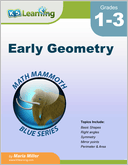 |
Basic shapes (rectangles, squares,...), right angles, symmetry, mirror points, perimeter and area. |
 |
Overview focused on basic plane geometry. Topics include lines, rays and angles; measuring angles; parallel and perpendicular lines, shapes, area, volume. Also rectangular prisms and surface area. |
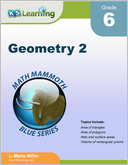 |
Areas and volumes of common shapes; polygons in a coordinate grid and areas of polygons. Area and perimeter problems, nets, surface area and volume problems including volume of rectangular prisms. |
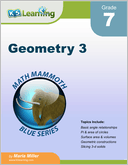 |
Angles and triangles, geometric constructions, pi and circles, area and perimeter problems, surface area, converting units of area, slicing 3-dimensional shapes and the volume of prisms and cylinders. |
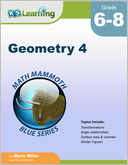 |
Geometry 4 Geometric transformations and congruence; translations, reflections, rotations, sequences of transformations. Similar figures, corresponding angles, angle relationships and parallel lines. Volume of prisms, cylinders, pyramids, cones and spheres. |
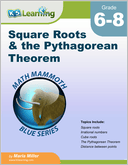 |
Square Roots & the Pythagorean Theorem Square roots, the Pythagorean Theorem, applications of the Pythagorean Theorem and a proof of the Pythagorean Theorem. |
